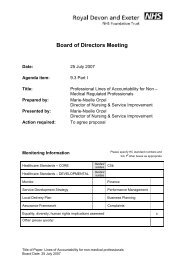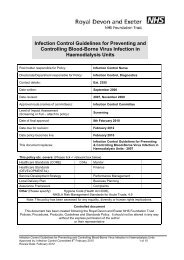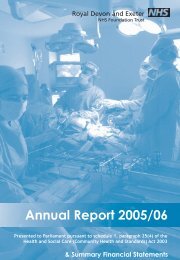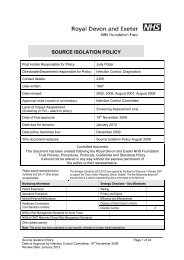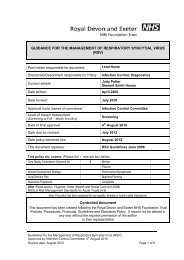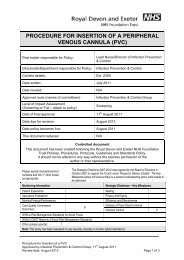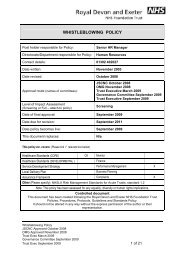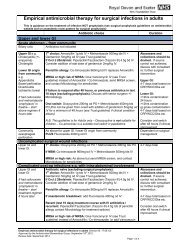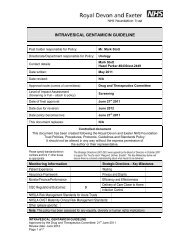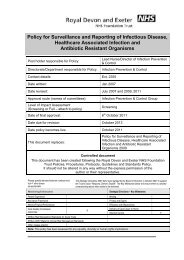Annual Report and Accounts 2012/13 - Royal Devon & Exeter Hospital
Annual Report and Accounts 2012/13 - Royal Devon & Exeter Hospital
Annual Report and Accounts 2012/13 - Royal Devon & Exeter Hospital
You also want an ePaper? Increase the reach of your titles
YUMPU automatically turns print PDFs into web optimized ePapers that Google loves.
38 2. <strong>2012</strong>/<strong>13</strong> Quality Schemes<br />
<strong>Royal</strong> <strong>Devon</strong> <strong>and</strong> <strong>Exeter</strong> NHS Foundation Trust<br />
Quality <strong>Report</strong> <strong>2012</strong>/<strong>13</strong><br />
<strong>2012</strong>/<strong>13</strong> Quality Schemes<br />
The Commissioning for Quality<br />
<strong>and</strong> Innovation (CQUIN) payment<br />
framework enables commissioners<br />
to reward excellence by linking a<br />
proportion of providers’ income to<br />
the achievement of local quality<br />
improvement goals. There are four<br />
nationally m<strong>and</strong>ated CQUIN goals<br />
(items 1-4) <strong>and</strong> a number of locally<br />
agreed goals.<br />
A summary of these CQUIN’s is set out<br />
below. Currently the Trust is on track to<br />
achieve all of the agreed measures apart<br />
from the Dementia CQUIN which was<br />
subject to in-year change (see *below).<br />
1. Venous Thromboembolism<br />
(VTE) Risk Assessment<br />
The percentage of eligible patients<br />
who were assessed for risk of<br />
developing a venous<br />
thromboembolism (blood clot).<br />
<strong>2012</strong>/<strong>13</strong> Target – 90%<br />
<strong>2012</strong>/<strong>13</strong> Achieved – 94.6%<br />
2. Patient Experience<br />
This indicator draws together<br />
the response of patients to<br />
five questions identified by the<br />
Department of Health that were<br />
in the <strong>2012</strong> National Inpatient<br />
Survey. The responses form an<br />
index-based score. The Trust’s<br />
score of 73.3 compares favourably<br />
with national benchmarks <strong>and</strong><br />
is an increase on last year’s<br />
achievement.<br />
<strong>2012</strong>/<strong>13</strong> Target – 73.5%<br />
<strong>2012</strong>/<strong>13</strong> Achieved – 73.3%<br />
3. Dementia Screening<br />
This indicator represents the<br />
Trust’s progress in meeting new<br />
national guidelines in relation<br />
to the early recognition of<br />
undiagnosed dementia. This<br />
indicator requires that the Trust<br />
identifies patients who may be<br />
exhibiting symptoms of dementia,<br />
assesses them <strong>and</strong> refers them on<br />
to appropriate care.<br />
3a. Dementia Case Finding<br />
The percentage of all patients<br />
aged 75 <strong>and</strong> above, admitted as<br />
emergency inpatients, who are<br />
asked the dementia case finding<br />
question within 72 hours of<br />
admission, or who have a clinical<br />
diagnosis of delirium on initial<br />
assessment or known diagnosis<br />
of dementia.<br />
<strong>2012</strong>/<strong>13</strong> Target – 90%<br />
<strong>2012</strong>/<strong>13</strong> – please see update<br />
below*<br />
3b. Dementia Diagnostic<br />
Assessment <strong>and</strong> Investigation<br />
The percentage of all patients<br />
aged 75 <strong>and</strong> above, admitted<br />
as emergency inpatients, who<br />
have scored positively on the<br />
case finding question, or who<br />
have a clinical diagnosis of<br />
delirium reported as having had a<br />
dementia diagnostic assessment<br />
including investigations.<br />
<strong>2012</strong>/<strong>13</strong> Target – 90%<br />
<strong>2012</strong>/<strong>13</strong> please see update below*<br />
3c. Referral for Specialist<br />
Diagnosis<br />
The percentage of all patients<br />
aged 75 <strong>and</strong> above, admitted<br />
as emergency inpatients, who<br />
have had a diagnostic assessment<br />
(in whom the outcome is either<br />
'positive' or 'inconclusive' who<br />
are referred for further diagnostic<br />
advice or follow up.<br />
<strong>2012</strong>/<strong>13</strong> Target – 90%<br />
<strong>2012</strong>/<strong>13</strong> – please see update<br />
below*<br />
* A developmental Dementia CQUIN was<br />
agreed with <strong>Devon</strong> PCT in April <strong>2012</strong>. In<br />
May <strong>2012</strong> national guidance was published<br />
which indicated payment was only available<br />
following the successful achievement of<br />
90% compliance with all three elements of<br />
the CQUIN across all eligible patients. <strong>Devon</strong><br />
PCT informed us that this would constitute<br />
a change to the CQUIN. Subsequently it has<br />
become apparent that not all commissioners<br />
have applied this guidance <strong>and</strong> are recognizing<br />
the complexity of the development work that<br />
this CQUIN entails. The commissioners have<br />
agreed a partial payment in recognition of<br />
the significant quality, cultural <strong>and</strong> systemic<br />
improvements that have been achieved for<br />
patients <strong>and</strong> carers living with dementia. The<br />
Commissioners have recognized this as partial<br />
achievement of the CQUIN target.<br />
4. Patient Safety Thermometer<br />
The Safety Thermometer is a<br />
nationally designed tool which<br />
monitors four types of potential<br />
harm:<br />
• Venous thromboembolism<br />
(blood clot)<br />
• Patient falls<br />
• Pressure ulcers



